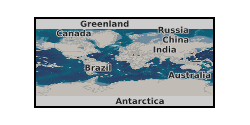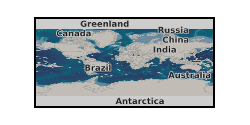Charcoal
Type of resources
Topics
Keywords
Contact for the resource
Provided by
Years
Formats
Representation types
Update frequencies
-

Supplementary material for published paper, Early Paleogene wildfires in peat-forming environments at Schoningen, Germany by BE Robson et al, http://doi.org/10.1016/j.palaeo.2015.07.016 NERC grant abstract: Human activity has led to an increase in pCO2 and methane levels from pre-industrial times to today. While the former increase is primarily due to fossil fuel burning, the increase in methane concentrations is more complex, reflecting not only direct human activity but also feedback mechanisms in the climate system related to temperature and hydrology-induced changes in methane emissions. To unravel these complex relationships, scientists are increasingly interrogating ancient climate systems. Similarly, one of the major challenges in palaeoclimate research is understanding the role of methane biogeochemistry in governing the climate of ice-free, high-pCO2 greenhouse worlds, such as during the early Paleogene (around 50Ma). The lack of proxies for methane concentrations is problematic, as methane emissions from wetlands are governed by precipitation and temperature, such that they could act as important positive or negative feedbacks on climate. In fact, the only estimates for past methane levels (pCH4) arise from our climate-biogeochemistry simulations wherein GCMs have driven the Sheffield dynamic vegetation model, from which methane fluxes have been derived. These suggest that Paleogene pCH4 could have been almost 6x modern pre-industrial levels, and such values would have had a radiative forcing effect nearly equivalent to a doubling of pCO2, an impact that could have been particularly dramatic during time intervals when CO2 levels were already much higher than today's. Thus, an improved understanding of Paleogene pCH4 is crucial to understanding both how biogeochemical processes operate on a warmer Earth and understanding the climate of this important interval in Earth history. We propose to improve, expand and interrogate those model results using improved soil biogeochemistry algorithms, conducting model sensitivity experiments and comparing our results to proxy records for methane cycling in ancient wetlands. The former will provide a better, process-orientated understanding of biogenic trace gas emissions, particularly the emissions of CH4, NOx and N2O. The sensitivity experiments will focus on varying pCO2 levels and manipulation of atmospheric parameters that dictate cloud formation; together, these experiments will constrain the uncertainty in our trace greenhouse gas estimates. To qualitatively test these models, we will quantify lipid biomarkers and determine their carbon isotopic compositions to estimate the size of past methanogenic and methanotrophic populations, and compare them to modern mires and Holocene peat. The final component of our project will be the determination of how these elevated methane (and other trace gas) concentrations served as a positive feedback on global warming. In combination our work will test the hypothesis that elevated pCO2, continental temperatures and precipitation during the Eocene greenhouse caused increased wetland GHG emissions and atmospheric concentrations with a significant feedback on climate, missing from most modelling studies to date. This work is crucial to our understanding of greenhouse climates but such an integrated approach is not being conducted anywhere else in the world; here, it is being led by international experts in organic geochemistry, climate, vegetation and atmospheric modelling, and palaeobotany and coal petrology. It will represent a major step forward in our understanding of ancient biogeochemical cycles as well as their potential response to future global warming.
-

This dataset is the output of a NERC fellowship aimed to understand the long-term dynamics of tropical vegetation through palaeoecological analysis. For doing this, two sedimentary archives (Laguna Pindo and Laguna Baños) from Ecuador were radiocarbon dated and analysed for pollen, non-pollen palynomorphs, charcoal, chironomids, stable isotopes and XRF of tephra deposits. Each proxy was analysed at different resolution. Laguna Pindo is a mid-elevation lake (1250 m asl) that spans the last 50,000 years. Laguna Baños is an Andean lake located at 3800 m asl and contains sediments representative of the last 6500 years. Both water bodies are very shallow. The data is presented mainly in excel spreadsheets as raw data (except for radiocarbon dating data, which are the PDF files provided by NRCF and are available in the NGDC), without any math treatment or conversion (unless specified). NERC fellowship is NE/J 018562/1.
-

Terrestrial palaeo-environmental proxy data has been collected to examine orbital changes in wildfire activity in the Early Jurassic of the Mochras Borehole, Cardigan Bay Basin, Wales. To do this a high resolution charcoal abundance dataset was created and quantified in two size fractions, microscopic charcoal (10-125 µ) and macroscopic charcoal (>125 µ). To take potential changes in riverine influx and/or organic preservation in account on the charcoal abundance, palynofacies were analysed to document all terrestrial and marine organic particles present in the samples, and next to this, X-ray fluorescence data was gathered to assess detrital output. Mass spectrometry provided information on the carbonate and Total Organic Carbon content and bulk organic carbon isotopes. This information was used to look at changes in the lithology and the carbon cycle. Finally, clay mineralogical data was obtained to look at changes in the hydrological cycle in relation to wildfire activity. This dataset spans 951-934 mbs from the Mochras borehole, which is the time equivalent of ~350 kyr, in the Margaritatus Zone of the Upper Pliensbachian. The Mochras sediments have been deposited in the Cardigan Bay Basin, Wales. At the time of deposition, this location was positioned in the Laurasian Seaway at a paleolatitude of ~35°N. These datasets were obtained at a high resolution (10 cm) using X-ray diffraction, X-ray fluorescence, mass spectrometry and palynological preparations. This high resolution was acquired to analyse the presence of precessional orbital forcing on wildfire and the other proxy datasets. This data was collected, interpreted and analysed by Teuntje Hollaar, Claire Belcher, Stephen Hesselbo, Micha Ruhl, Jean-Franҫois Deconinck, Sarah Jane Baker and Luke Mander. The complete dataset presented in the published article file ‘Wildfire activity enhanced during phases of maximum orbital eccentricity and precessional forcing in the Early Jurassic’ has been included in this data file.
 NERC Data Catalogue Service
NERC Data Catalogue Service